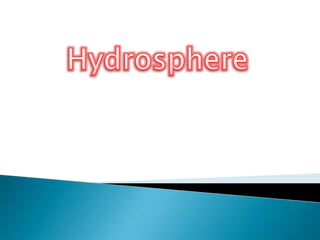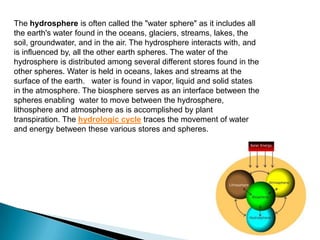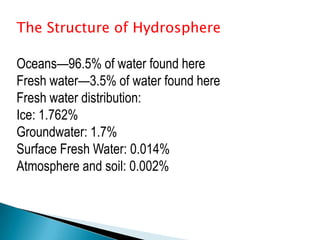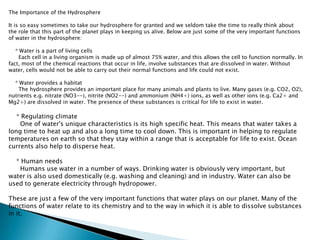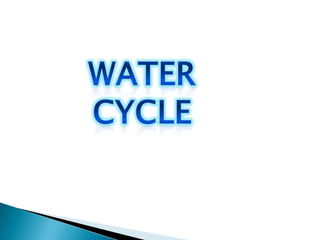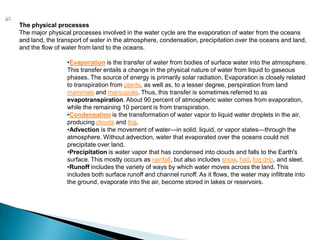hydrosphere
- 1. Hydrosphere
- 2. The hydrosphere is often called the "water sphere" as it includes all the earth's water found in the oceans, glaciers, streams, lakes, the soil, groundwater, and in the air. The hydrosphere interacts with, and is influenced by, all the other earth spheres. The water of the hydrosphere is distributed among several different stores found in the other spheres. Water is held in oceans, lakes and streams at the surface of the earth. water is found in vapor, liquid and solid states in the atmosphere. The biosphere serves as an interface between the spheres enablingĚý water to move between the hydrosphere, lithosphere and atmosphere as is accomplished by plant transpiration. The hydrologic cycle traces the movement of water and energy between these various stores and spheres.
- 3. The Structure of HydrosphereOceans—96.5% of water found hereFresh water—3.5% of water found hereFresh water distribution:Ice: 1.762%Groundwater: 1.7%Surface Fresh Water: 0.014%Atmosphere and soil: 0.002%
- 4. The Importance of the HydrosphereIt is so easy sometimes to take our hydrosphere for granted and we seldom take the time to really think about the role that this part of the planet plays in keeping us alive. Below are just some of the very important functions of water in the hydrosphere: * Water is a part of living cells Each cell in a living organism is made up of almost 75% water, and this allows the cell to function normally. In fact, most of the chemical reactions that occur in life, involve substances that are dissolved in water. Without water, cells would not be able to carry out their normal functions and life could not exist. * Water provides a habitat The hydrosphere provides an important place for many animals and plants to live. Many gases (e.g. CO2, O2), nutrients e.g. nitrate (NO3--), nitrite (NO2--) and ammonium (NH4+) ions, as well as other ions (e.g. Ca2+ and Mg2+) are dissolved in water. The presence of these substances is critical for life to exist in water. * Regulating climate One of water's unique characteristics is its high specific heat. This means that water takes a long time to heat up and also a long time to cool down. This is important in helping to regulate temperatures on earth so that they stay within a range that is acceptable for life to exist. Ocean currents also help to disperse heat. * Human needs Humans use water in a number of ways. Drinking water is obviously very important, but water is also used domestically (e.g. washing and cleaning) and in industry. Water can also be used to generate electricity through hydropower.These are just a few of the very important functions that water plays on our planet. Many of the functions of water relate to its chemistry and to the way in which it is able to dissolve substances in it.
- 5. Water Cycle
- 6. water cycle, or the hydrologic cycle, is the continuous circulation of water within the Earth's hydrosphere. It involves the movement of water into and out of various reservoirs, including the atmosphere, land, surface water, and groundwater. This cycle is driven by radiation from the Sun. The movement of water within the water cycle is the subject of the field of hydrology.The water moves from one reservoir to another, such as from river to ocean, or from the ocean to the atmosphere, by the physical processes of evaporation, condensation, precipitation, infiltration, runoff, and subsurface flow. In so doing, the water goes through different phases: liquid, solid, and gas.The water cycle also involves the exchange of heat energy, which leads to temperature changes. For instance, in the process of evaporation, water takes up energy from the surroundings and cools the environment. Conversely, in the process of condensation, water releases energy to its surroundings, warming the environment.The water cycle figures significantly in the maintenance of life and ecosystems on Earth. Even as water in each reservoir plays an important role, the water cycle brings added significance to the presence of water on our planet. By transferring water from one reservoir to another, the water cycle purifies water, replenishes the land with freshwater, and transports minerals to different parts of the globe. It is also involved in reshaping the geological features of the Earth, through such processes as erosion and sedimentation. In addition, as the water cycle involves heat exchange, it exerts an influence on climate as well.
- 7. The physical processesThe major physical processes involved in the water cycle are the evaporation of water from the oceans and land, the transport of water in the atmosphere, condensation, precipitation over the oceans and land, and the flow of water from land to the oceans.Evaporation is the transfer of water from bodies of surface water into the atmosphere. This transfer entails a change in the physical nature of water from liquid to gaseous phases. The source of energy is primarily solar radiation. Evaporation is closely related to transpiration from plants, as well as, to a lesser degree, perspiration from land mammals and marsupials. Thus, this transfer is sometimes referred to as evapotranspiration. About 90 percent of atmospheric water comes from evaporation, while the remaining 10 percent is from transpiration.
- 8. Condensation is the transformation of water vapor to liquid water droplets in the air, producing clouds and fog.
- 9. Advection is the movement of water—in solid, liquid, or vapor states—through the atmosphere. Without advection, water that evaporated over the oceans could not precipitate over land.
- 10. Precipitation is water vapor that has condensed into clouds and falls to the Earth's surface. This mostly occurs as rainfall, but also includes snow, hail, fog drip, and sleet.
- 11. Runoff includes the variety of ways by which water moves across the land. This includes both surface runoff and channel runoff. As it flows, the water may infiltrate into the ground, evaporate into the air, become stored in lakes or reservoirs.Conservation of massThe total amount, or mass, of water in the water cycle remains essentially constant, as does the amount of water in each reservoir of the water cycle. This means that the rate of water added to one reservoir must equal, on average over time, the rate of water leaving the same reservoir.The adjacent table contains the amount of water that falls as precipitation or rises as evaporation, for both the land and oceans. The runoff and groundwater discharge from the land to the oceans is also included. From the law of conservation of mass, whatever water moves into a reservoir, on average, the same volume must leave. For example, 107 thousand cubic kilometers (107 Ă— 10Âł kmÂł) of water falls on land each year as precipitation. This is equal to the sum of the evaporation (71 Ă— 10Âł kmÂł/year) and runoff (36 Ă— 10Âł kmÂł/year) of water from the land.Water that cycles between the land and the atmosphere in a fixed area is referred to as moisture recycling.
- 12. ReservoirsIn the context of the water cycle, a reservoir represents a region or zone where water is stored at a certain stage of the water cycle. The largest reservoir is the collection of oceans, accounting for 97 percent of the Earth's water. The next largest quantity (2 percent) is stored in solid form in the ice caps and glaciers. The water contained within all living organisms represents the smallest reservoir. Freshwater reservoirs, particularly those available for human use, are important

